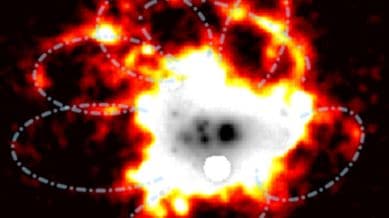Click here to join Express Pune WhatsApp channel and get a curated list of our stories
Surprising discovery by Pune IUCAA astronomers: A small galaxy that blows large bubbles
The diameter of the bubbles, 23.000 light-years, is almost as large as the distance from Earth to the black hole in the centre of the Milky Way, said IUCAA astronomers Dr Edmund Christian Herenz (Vaidya-Raychaudhuri Fellow) and Soumil Maulick on Thursday.

Two astronomers from the Inter-University Centre for Astronomy and Astrophysics (IUCAA), Pune, in collaboration with an astronomer from the University of Tokyo, have captured a spectacular galactic wind phenomenon around a very tiny galaxy called J1044+0353.
“This tiny galaxy (diameter 7.100 light-years) is vigorously forming stars. It is at a distance of 170 million light-years from us. The surprising finding is that it is surrounded by seven giant bubbles,” said IUCAA astronomers Dr Edmund Christian Herenz (Vaidya-Raychaudhuri Fellow) and Soumil Maulick on Thursday.
The diameter of those bubbles, 23.000 light-years, is almost as large as the distance from Earth to the black hole in the centre of the Milky Way, they said in a statement. “While a few of these bubbles look like they have popped, others are still remarkably intact,” they added.
According to them, stars that are 25 to 100 times more massive than the Sun do not live very long. After three to five million years, their cores collapse and giant nuclear explosions, dubbed supernovae, blast vast amounts of material into the surrounding space.
“In our Milky Way, such supernovae occur, on average, thrice a century. Given our home Galaxy’s large mass and size, these explosions only have a modest effect on the overall interstellar gas distribution,” the scientists explained.
However, similar supernovae rates may have dramatic consequences for galaxies that are 10,000 times less massive than the Milky Way. This is because their gravitational pull cannot hold back the high-velocity gas released from all the explosions in such systems. Thus, gas is being blown out in a so-called galactic wind. Making direct images of this wind material is challenging, even with the largest telescopes, since the wind material is very diffuse.
According to the astronomers, large-scale wind-driven bubbles around small galaxies have been known for two decades, but the newly discovered bubbles are twice to thrice as large as anything seen before. Classical models of large-scale bubble formation due to the combined effect from supernovae fail to reproduce the properties of the observed structure around J1044+0353.
“Understanding wind phenomena around starburst galaxies is key for grasping galaxy formation and evolution in the early universe, where galaxies such as J1044+0353 are the norm. Yet, to comprehend how these winds really work, we need to collect more such images of diffuse gas around tiny galaxies. Currently, we even do not know whether the structure around J1044+0353 is truly special or whether many more tiny galaxies may blow similar super-sized bubbles,” Maulick added.
Click here to join Express Pune WhatsApp channel and get a curated list of our stories